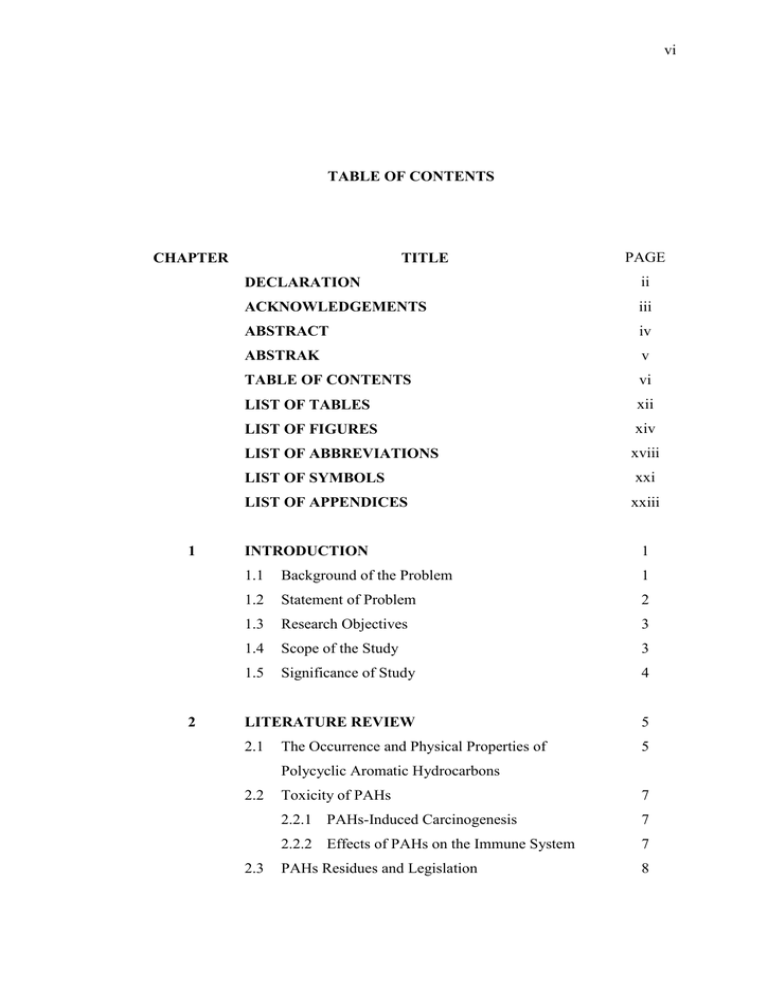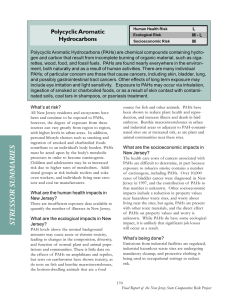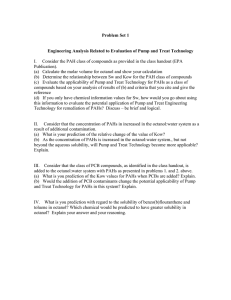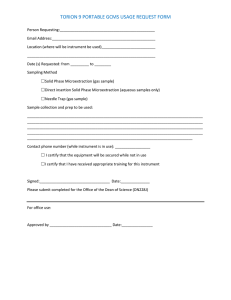Document 14618012
advertisement

vi TABLE OF CONTENTS CHAPTER 1 2 TITLE PAGE DECLARATION ii ACKNOWLEDGEMENTS iii ABSTRACT iv ABSTRAK v TABLE OF CONTENTS vi LIST OF TABLES xii LIST OF FIGURES xiv LIST OF ABBREVIATIONS xviii LIST OF SYMBOLS xxi LIST OF APPENDICES xxiii INTRODUCTION 1 1.1 Background of the Problem 1 1.2 Statement of Problem 2 1.3 Research Objectives 3 1.4 Scope of the Study 3 1.5 Significance of Study 4 LITERATURE REVIEW 5 2.1 5 The Occurrence and Physical Properties of Polycyclic Aromatic Hydrocarbons 2.2 2.3 Toxicity of PAHs 7 2.2.1 PAHs-Induced Carcinogenesis 7 2.2.2 Effects of PAHs on the Immune System 7 PAHs Residues and Legislation 8 vii 2.4 Sample Preparation Techniques for PAHs Residues 9 in Water and Food 2.5 2.4.1 Extraction and Clean-up of PAHs in Water 10 2.4.2 Extraction and Clean-up of PAHs in Food 10 2.4.2.1 Fatty Food 11 2.4.2.2 Non Fatty Food 12 Alternative Green Microextraction Techniques 13 2.5.1 Supercritical Fluid Extraction 14 2.5.2 Subcritical or Superheated Water Extraction 14 2.5.3 Solid Phase Microextraction 16 2.5.3.1 Basic Principles of SPME 18 2.5.4 Stir Bar Sorptive Extraction (SBSE) 18 2.5.5 Microextraction in Packed Syringe (MEPS) 20 2.5.6 Membrane Protected Micro Solid Phase 21 Extraction 2.5.7 Liquid Phase Microextraction 3 22 2.5.7.1 Basic Principles of LPME 25 2.5.8 Dispersive Liquid-liquid Microextraction 27 2.6 Summary of Past Reports on PAHs Analysis 28 2.7 Triazine Herbicides 34 2.8 Physical and Chemical Properties of Agarose 37 2.9 Application of Agarose 39 DETERMINATION OF POLYCYCLIC AROMATIC 40 HYDROCARBONS IN FRESH MILK BY HOLLOW FIBER LIQUID PHASE MICROEXTRACTION-GAS CHROMATOGRAPHY-MASS SPECTROMETRY 3.1 Introduction 40 3.2 Experimental 42 3.2.1 Chemicals and Reagents 42 3.2.2 Materials 42 3.2.3 Chromatographic Conditions 43 viii 3.2.4 Hollow Fiber Liquid Phase Microextraction 43 (HF-LPME) 4 3.2.5 Saponification prior to Solvent Extraction 44 3.2.6 Validation of Analytical Method 45 3.3 Results and Discussion 45 3.4 Conclusions 51 AGAROSE FILM LIQUID PHASE 52 MICROEXTRACTION OF POLYCYCLIC AROMATIC HYDROCARBONS IN WATER 4.1 Introduction 52 4.2 Experimental 54 4.2.1 Chemicals and Reagents 54 4.2.2 Materials 54 4.2.3 Chromatographic Conditions 55 4.2.4 Preparation of Agarose Film 55 4.2.5 Agarose Film Liquid Phase Microextraction 56 (AF-LPME) 4.3 4.2.6 Validation of Analytical Method 57 4.2.7 Sample Analysis 57 Results and Discussion 58 4.3.1 Optimization of AF-LPME 58 4.3.1.1 Stirring Speed 58 4.3.1.2 Extraction Time 59 4.3.1.3 Salting Out Effect 60 4.3.1.4 Agarose Concentration 61 4.3.1.5 Acceptor Phase Volume 63 4.3.2 Validation of AF-LPME 64 4.3.3 Application of AF-LPME on Environmental 66 Water Samples 4.4 4.3.4 Comparison with Other Reported Methods 67 Conclusions 70 ix 5 SOLVENT-IMPREGNATED AGAROSE GEL 71 LIQUID PHASE MICROEXTRACTION FOR THE ANALSIS OF POLYCYCLIC AROMATIC HYDROCARBONS AND TRIAZINE HERBICIDES 5.1 Introduction 71 5.2 Experimental 73 5.2.1 Chemicals and Reagents 73 5.2.2 Materials 74 5.2.3 Chromatographic Conditions 74 5.2.4 Preparation of Solvent Impregnated Agarose 75 Gel Disc 5.2.5 Solvent-Impregnated Agarose Gel Liquid 76 Phase Microextraction (AG-LPME) 5.2.6 Polypropylene Hollow Fiber Liquid Phase 77 Microextraction (HF-LPME) 5.2.7 Agarose Film Liquid Phase Microextraction 78 (AF-LPME) 5.3 5.2.8 Sample Analysis 78 Results and Discussion 78 5.3.1 Optimization of Solvent-Impregnated AG- 78 LPME for the Analysis of PAHs 5.3.1.1 Stirring Speed 79 5.3.1.2 Extraction Time 80 5.3.1.3 Agarose Concentration 81 5.3.1.4 Length of Agarose Gel Disc 83 5.3.2 Optimization of HF-LPME for the Analysis 84 of PAHs 5.3.3 Comparison of Extraction Efficiencies of 86 PAHs Among AG-LPME, AF-LPME and HF-LPME. 5.3.4 Validation of AG-LPME for the Analysis of PAHs 88 x 5.3.5 Application of AG-LPME on Drinking 89 Water Samples for the Analysis of PAHs 5.3.6 Optimization of Solvent-Impregnated AG- 90 LPME for the Analysis of Triazine Herbicides 5.3.6.1 Stirring Speed 91 5.3.6.2 Extraction Time 92 5.3.6.3 Sample pH 93 5.3.6.4 Salting Out Effect 94 5.3.7 Optimization of HF-LPME for the Analysis 95 of Triazine Herbicides 5.3.8 Comparison of Extraction Efficiencies of 97 Triazine Herbicides between AG-LPME and HF-LPME 5.3.9 Validation of AG-LPME for the Analysis of 99 Triazine Herbicides 5.4 6 Conclusions MULTI-WALLED CARBON NANOTUBE- 101 102 IMPREGNATED AGAROSE FILM MICROEXTRACTION OF POLYCYCLIC AROMATIC HYDROCARBONS IN GREEN TEA BEVERAGE 6.1 Introduction 102 6.2 Experimental 103 6.2.1 Chemicals and Materials 103 6.2.2 Chromatographic Conditions 104 6.2.3 Preparation of Multi-Walled Carbon 104 Nanotube-Impregnated Agarose Film (MWCNT-AF) 6.2.4 Multi-Walled Carbon NanotubeImpregnated Agarose Film Microextraction (MWCNT-AFME) 105 xi 6.3 6.2.5 Validation of Analytical Method 106 6.2.6 Sample Analysis 106 Results and Discussion 107 6.3.1 Optimization of MWCNT-AFME 107 6.3.1.1 Conditioning Solvent 107 6.3.1.2 Sample Volume, Concentration of 107 MWCNTs and Number of Films 6.3.1.3 Desorption Time and Desorption 111 Solvent 6.3.1.4 Stirring Speed and Extraction Time 113 6.3.2 Validation of MWCNT-AFME 115 6.3.3 Application of MWCNT-AFME on Green 117 Tea Beverage Samples 6.4 7 6.3.4 Comparison with Other Reported Methods 117 Conclusions 119 CONCLUSIONS AND FUTURE DIRECTIONS 120 7.1 Conclusions 120 7.2 Future Directions 122 REFERENCES Appendices A - D 124 143-146 xii LIST OF TABLES TABLE NO. TITLE PAGE 2.1 Physical properties of several PAHs. 6 2.2 Published methods for the extraction and determination of 29 PAHs from milk samples. 2.3 Published methods for the extraction and determination of 31 PAHs from aqueous samples. 2.4 Published methods for the extraction and determination of 34 PAHs from tea samples. 2.5 Published methods for the extraction and determination of 36 triazine herbicides from aqueous samples. 3.1 Validation data of HF-LPME of PAHs from milk. 49 3.2 Fat contents and slopes of calibration plots of different 49 milk samples. 3.3 PAHs residues in commercial fresh milk products (n=3). 50 3.4 Relative recovery study. 51 4.1 Characterization of agarose film. 63 4.2 Validation data of AF-LPME of PAHs from spiked river 65 water sample, n=3 4.3 Relative recovery study of AF-LPME on river water 66 4.4 Application of AF-LPME on environmental water 67 samples. 4.5 Comparison of the AF-LPME with other published 69 methods for the extraction and determination of PAHs from water samples. 5.1 Validation data of AG-LPME of PAHs from spiked drinking water samples (n=3). 89 xiii 5.2 Relative recovery studies of AG-LPME using PAHs 89 spiked drinking water. 5.3 Application of AG-LPME on drinking water samples for 90 the analysis of PAHs (n=3). 5.4 Validation data of AG-LPME of triazine herbicides using 100 spiked drinking water samples (n=3). 5.5 Relative recovery studies of AG-LPME using triazine 101 herbicides spiked drinking and river water samples (n=3). 6.1 Validation data of MWCNT-AFME of PAHs from green 115 tea beverage samples (n=3). 6.2 Relative recovery studies of MWCNT-AFME using spiked 116 green tea beverage samples (n=3). 6.3 Application of MWCNT-AFME on green tea beverage 117 samples (n=3). 6.4 Comparison of the MWCNT-AFME with other published methods for the extraction and determination of PAHs from tea samples. 118 xiv LIST OF FIGURES FIGURE NO. TITLE PAGE 2.1 Schematic of SPME procedures. 16 2.2 Stir bar coated with PDMS. 19 2.3 Schematic of SPMTE (See et al., 2010). 20 2.4 Design of membrane protected micro solid phase 21 extraction. 2.5 Configuration A and B in LPME (Psillakis and 23 Kalogerakis, 2003). 2.6 Two-phase and three-phase sampling modes LPME 24 (Psillakis and Kalogerakis, 2003). 2.7 Schematic of cone-shaped LPME (Sanagi et al., 2007). 25 2.8 Schematic of DLLME procedures. 27 2.9 Chemical structure of agarose. 37 2.10 (a) Basic repeat units of agarose; (b) Schematic of gelling 39 process of agarose (Zhou et al., 2006a). 3.1 Schematic of HF-LPME. 44 3.2 Effect of stirring speed on HF-LPME of PAHs in milk. 46 3.3 Effect of salting out on HF-LPME of PAHs in milk. 47 3.4 Effect of extraction time on HF-LPME of PAHs in milk. 48 4.1 (a) Agarose film and (b) glass tube that is used in agarose 56 film liquid phase microextraction. 4.2 Schematic of AF-LPME system. 57 4.3 Effect of stirring speed on AF-LPME of PAHs from 59 water sample. 4.4 Effect of extraction time on AF-LPME of PAHs from water sample. 60 xv 4.5 Effect of salting out on AF-LPME of PAHs from water 61 sample. 4.6 Effect of agarose concentration on AF-LPME of PAHs 62 from water samples. 4.7 FESEM image of the 0.8% agarose film. 63 4.8 Effect of acceptor phase volume on AF-LPME of PAHs 64 from water sample. 4.9 GC-MS analysis of four polycyclic aromatic 66 hydrocarbons spiked at 100 µg L-1 of river water on Agilent HP5 MS column (30 m × 0.25 mm i.d., 0.25 µm film thickness). 5.1 (a) Agarose gel disc; (b) Agarose gel discs dipped in 70% 76 ethanol solution. 5.2 Schematic of AG-LPME system. 77 5.3 Effect of stirring speed on AG-LPME of PAHs from 80 water sample. 5.4 Effect of extraction time on AG-LPME of PAHs from 81 water sample. 5.5 Effect of agarose concentration on AG-LPME of PAHs 82 from water sample. 5.6 Effect of agarose disc length on AG-LPME of PAHs 83 from water sample. 5.7 Effect of stirring speed on HF-LPME of PAHs from 84 water sample. 5.8 Effect of extraction time on HF-LPME of PAHs from 85 water sample. 5.9 Comparison of extraction efficiencies among AG-LPME, AF-LPME and HF-LPME. Error bars followed by same letter without string showed no significant difference according to Anova, Tukey test p>0.05. 87 xvi 5.10 GC-MS total ion chromatogram (TIC) of four PAHs 88 obtained after (a) AG-LPME and (b) HF-LPME spiked at 40 µg L-1 of deionized water. Conditions: helium constant flowrate of 1 mL min-1, oven temperature profile was programmed at 150oC for 3 min, and then increased to 250oC at 10C min-1 using Agilent HP5 MS column (30 m × 0.25 mm i.d., 0.25 µm film thickness). 5.11 Effect of stirring speed on AG-LPME of triazines from 91 water sample. 5.12 Effect of extraction time on AG-LPME of triazines from 92 water sample. 5.13 Effect of sample pH on AG-LPME of triazines from 93 water sample. 5.14 Effect of salting out on AG-LPME of triazines from 94 water sample. 5.15 Effect of stirring speed on HF-LPME of triazines from 95 water sample. 5.16 Effect of extraction time on HF-LPME of triazines from 96 water sample. 5.17 Comparison of extraction efficiencies between AG- 98 LPME and HF-LPME. Error bars followed by same letter without string showed no significant difference according to t-test, p>0.05. 5.18 GC-MS total ion chromatogram (TIC) of three triazine 99 herbicides obtained after (a) AG-LPME and (b) HFLPME spiked at 4 µg L-1 of deionized water. Conditions: helium constant flowrate of 1 mL min-1, oven temperature profile was programmed at 170oC, and then increased to 206oC at 3oC min-1 using Agilent HP5 MS column (30 m × 0.25 mm i.d., 0.25 µm film thickness). 5.19 GC-MS TIC of (a) drinking and (b) river water samples that were free from triazines and used for relative recovery studies. 100 xvii 6.1 Schematic drawing of MWCNT-AFME system. 106 6.2 Effect of sample volume on MWCNT-AFME of PAHs 108 from water sample. 6.3 Effect of concentration of MWCNTs on MWCNT- 109 AFME of PAHs from water sample. The surface area of the 0.1, 0.3 and 0.6% of MWCNTs impregnated within the agarose film were 21.4, 37.6 and 52.0 m2 g-1, respectively. 6.4 FESEM image of the (a) 0.3% MWCNT-AF and (b) AF; 110 the pictures on the right top corner of each image were the actual image of the circular films. 6.5 Effect of pieces of MWCNTs-AF on MWCNT-AFME of 111 PAHs from water sample. 6.6 Effect of desorption solvent on MWCNT-AFME of 112 PAHs from water sample. 6.7 Effect of stirring speed on MWCNT-AFME of PAHs 113 from water sample. 6.8 Effect of extraction time on MWCNT-AFME of PAHs 114 from water sample. 6.9 µ-HPLC-UV analysis of three PAHs spiked at 0.008 µg L-1 for both PHE and FLA and 5 µg L-1 for BaP of green tea beverage on Agilent ZORBAX Eclipse Plus C18 column (2.1 × 100 mm, 3.5 µm). µ-HPLC conditions: isocratic mobile phase ACN-water (80:20) (v/v), column temperature at 25oC, flowrate at 0.2 mL min-1, injection volume of 2 µL and detection wavelength at 254 nm. 116 xviii LIST OF ABBREVIATIONS ACE - Acetone ACT - Acetonitrile AF - Agarose film AF-LPME - Agarose film liquid phase microextraction AG - Agarose gel AG-LPME - Agarose gel liquid phase microextraction AOAC - Association of Analytical Communities ATR - Atrazine BaP - Benzo[a]pyrene BET - Brunauer Emmett Teller CYN - Cyanazine DAD - Diode array detector DCM - Dichloromethane DLLME - Dispersive liquid-liquid microextraction DNA - Deoxyribonucleic acid EF - Enrichment factor EME - Electromembrane extraction EtOH - Ethanol EU - European Union FD - Fluorescence detector FESEM - Field emission scanning electron microscope FLA - Fluoranthene FLU - Fluorene GC - Gas chromatography HF - Hollow fiber HF-LPME - Hollow fiber liquid phase microextraction HPLC - High performance liquid chromatography xix HS - Headspace I.D. - Internal diameter IL - Ionic liquid IPA - Isopropyl alcohol LLE - Liquid-liquid extraction LOD - Limit of detection LOQ - Limit of quantification LPME - Liquid phase microextraction LVI - Large volume injection MASE - Membrane assisted solvent extraction ME - Microextraction MEPS - Microextraction in packed syringe MRL - Maximum residue level MS - Mass spectrometry MWCNT-AF MWCNT-AFME Multi-walled carbon nanotube-impregnated agarose film - Multi-walled carbon nanotube-impregnated agarose film microextraction MWCNTs - Multi-walled carbon nanotubes NaCl - Sodium chloride PAHs - Polycyclic aromatic hydrocarbons PCBs - Polychlorinated biphenyls PDA - Photodiode array PDMS - Polydimethylsiloxane PE - Polyethylene PHE - Phenanthrene PP - Polypropylene PTV - Programmed temperature vaporization PYR - Pyrene RSD - Relative standard deviation RTP - Room temperature phosphorimetry SBSE - Stir bar sorptive extraction SDME - Single drop microextraction SE - Solvent extraction xx SEC - Secbumeton SFE - Subcritical fluid extraction SFO - solidification of floating organic drop SIM - Selected ion monitoring SIR - Solvent impregnated resin SPE - Solid phase extraction SPME - Solid phase microextraction SPMTE - Solid phase membrane tip extraction SWE - Subcritical or superheated water extraction THF - Tetrahydrofuran USEPA - United States Environmental Protection Agency UV - Ultraviolet WHO - World Health Organization µHPLC - Micro high performance liquid chromatography µ-SPE - Micro solid phase extraction xxi LIST OF SYMBOLS pKa - Acid dissociation constant n - Amount of analyte extracted by the coating CO2 - Carbon dioxide R2 - Coefficient of determination CW - Concentration of analyte in the aqueous sample solution CO - Concentration of analyte in the organic extraction solvent r - Correlation coefficient o C - Degree Celsius eV - Electronvolt K - Equilibrium distribution coefficient Kfs - Fiber coating/sample matrix distribution constant Vf - Fiber coating volume g - Gram g mol-1 - Gram per mole h - Hour C0 w - Initial amount of the analyte C0 - Initial concentration of the analyte in the sample kV - Kilovolts L - Liter m - Meter µ - Micro µg - Microgram µg g-1 - Microgram per gram µg kg-1 - Microgram per kilogram µg L-1 - Microgram per liter µm - Micrometer mg - Milligram xxii mg L-1 - Milligram per liter mL - Milliliter mm - Millimeter min - Minutes - Nanogram ng L - Nanogram per liter Kow - 1-octanol/water partitioning coefficients ppb - Part per billion % - Percent p - Probability rpm - Revolutions per minute Vs - Sample volume s - Seconds Vw - Volume of aqueous sample solution Vo - Volume of organic extraction solvent w/v - Weight per volume ng -1 xxiii LIST OF APPENDICES APPENDIX TITLE PAGE A List of Publications from this Study 143 B List of Awards from this Study 144 C List of Presentations Related to this Study 145 D List of Patents Related to this Study 146






